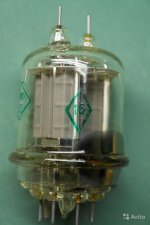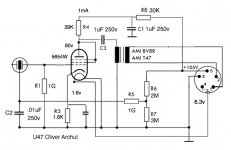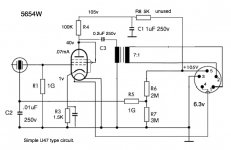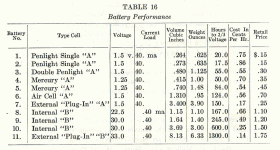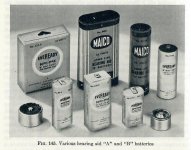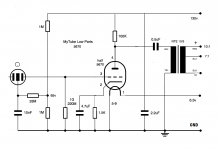I've nearly finished a line stage for my audio system so I can test a variety of tubes out and hear them in stereo through my hifi. Should give me some idea of the sound and also the operating points. I'll do some testing. Should be very interesting! I have a pair of Lundahl LL1689 I can use in 9:1 for the step-down. I'm using 105v as the B+, using a 0C3 glow tube voltage reg. I've got a pair of 7 pin sockets ready for the 5654W and I'll also add a pair of 9 pin sockets for other tubes. Looking forward to this.
Nobody wanted to go to prison for the tube failed in a military equipment during the warranty time. 😀
Obviously not... You´re still around 😀😀😀
Jokes aside.... Was it really that bad during those times???
I´ve often wondered about all the different OTK-numbers. Think, the highest I´ve seen is 68. Were these numbers code for a QC-person???
OP... sorry for Off Topic 🙂
Obviously not... You´re still around 😀😀😀
Jokes aside.... Was it really that bad during those times???
I´ve often wondered about all the different OTK-numbers. Think, the highest I´ve seen is 68. Were these numbers code for a QC-person???
OTK numbers are not related to quality, they were assigned to persons who tested the production.
A different story, is a "Requestor's Acceptance". The requestor, obviously, was a military entity, and acceptance number means special conditions. like, 9 for nuclear and space programs. "Military Acceptance" sign was either a diamond, or a star (earlier). Acceptance 5 means for any army, navy, or fleet special conditions, it is universal. There are other acceptance numbers, for different special conditions.
Here is an example attached. OTK person number 33 guaranteed the tube, also it was accepted for special conditions number 16.
Attachments
What I don't get with subminiature tubes is why they are used in microphones when they have a relatively short lifetime compared with the more usual 7 and 9 pin types. 5840 lifetime is "not less than 450hrs"......
There were MANY applications of "subminiature" tubes, with very different requirements.
Bomb fuses
Hearing aids
Weather balloons
Small wall-power gear
A bomb proximity fuse has a working life of a few minutes, but must be highly reliable (go off when the expensive bomb nears a target, but NOT before).
Weather balloons have a working life of 2 hours tops, though ~~1/4 of these got found and returned so a "lucky" tube might rack-up 10 hours.
Hearing aids EAT batteries. Battery cost exceeds tube replacement cost until the tube is built super low-power and fragile. (Same is true for Beach Radios: you could hardly afford enough batteries to wear-out the tubes.)
Wall-power gear is different. The tube guts would be derived from conventional tubes of long life using a good amount of power and robust heaters/filaments. However the too-small bottle cramps the heat and seals. Average life could be good or less-good.
I've been steadily building a line stage to prototype the circuit I'll use in my tube mic, build. Target mic circuit attached. I've catered for 7 pin and 9 pin tubes.
For 7 pin I have a couple of 5654W. I'm also interested in 6AU6 or the equivalent GE 8425A used in vintage Sony mics. Same pinout.
For 9 pin I have single EF86 same pinout as EF83
For 9 pin I also have single EF184, pinout as EF800 used in U47 clones, EF802, EF860, 6ZH51P and others
Will report further when I have something up and running. It will be a temptation to buy a few of these tubes to try out. That's a slippery slope......
For 7 pin I have a couple of 5654W. I'm also interested in 6AU6 or the equivalent GE 8425A used in vintage Sony mics. Same pinout.
For 9 pin I have single EF86 same pinout as EF83
For 9 pin I also have single EF184, pinout as EF800 used in U47 clones, EF802, EF860, 6ZH51P and others
Will report further when I have something up and running. It will be a temptation to buy a few of these tubes to try out. That's a slippery slope......
Attachments
Looks like I've been on the wrong path here, looking at good audio tubes which conventionally operate at higher plate voltages and current. I came across this thread which totally changes the picture, and one of the main contributors is PRR above.
desirable characteristics for microphone tubes?
"For obvious safety reasons, tubes in microphones are generally run at lowish voltages (50-100V Vak from a 100-200V supply). In order to minimise grid current, they're run at low current (<1mA). The output impedance of the tube stage will be quite high as a result. Spec sheet don't tell all because the tubes in a mic are used way out of specs, e.g. with a 1Gohm grid resistor. The most revered tube for mic applications, the VF14 is used in the U47 at an operating point that's clearly out of the chartered zone, even the heater voltage is different!"
"Assuming the "typical" circuit e.g. C-12 or M49; common cathode, transformer coupled, no feedback. You will likely want to operate the tube at less than 1 mA idle to reduce the grid "leakage" current. The data sheet numbers for gm & Rp are usually given for a higher operating current than you would use in a microphone. Rp is much higher at low plate current. There is a design relationship with the Rp and transformer ratio which determines the output impedance of the mic. Output impedance = Rp / (turns ratio ^2) Typical Zout target is on the order of 200 ohms. Transformer ratios typically used in tube mics vary from 5:1 to 14:1, giving an impedance multiplier of somewhere between 25 and 200. The amplification factor (much less at low current, also can be read off the actual load line) divided by the transformer ratio equals the gain from the capsule to the output. This determines microphone sensitivity. Typically this gain is between 0 and 6 dB. You can calculate the loaded capsule output from the capsule capacitance, capsule sensitivity, and capsule circuit loading. I like to shoot for about 20 mV/Pa sensitivity. The gm of the tube is the ratio of amplification factor to Rp, and is a sort of "figure of merit" for the desirable combination of high gain and low Rp. gm is of course less at low plate current. Assuming you are starting with the capsule selection, you need enough gm to achieve the desired gain and Zout with a given transformer.
- For example, the 6072 as used in the C12 runs at about 40K ohms plate resistance and uses a 14:1 transformer. The amplification factor in circuit is ~20, so there is about 3dB gain and about 200 ohms Zout. (numbers from memory...)
- The AC701 as used in the M49 runs at about 10K ohms Rp in circuit and has a gain of about 15. The transformer ratio at 7:1 yields Zout of something like 200 ohms with a gain about 6 dB. (also from memory...)"
So we're looking at tubes that have to perform in an unusual situation, way out of the data sheet with high Rp and tiny current. For instance, before reading all this I couldn't understand why the schematics were using 100k plate resistors instead of the more usual 27k-47K-ish you see at higher currents and voltages. The list of recommended pentodes in triode is more like EF42, EF80, EF800 and EF802. Some others seem to work like 5654W and EF86 and all the twin triodes that were used like 6072. But choosing a "good tube" on paper like E180F or 6J49P or D3a may or may not work - they weren't used in microphones as far as I can see. Only recommendations from builders who have tried the less used tubes, e.g. EF184, can establish any guide to what works.
I haven't finished my test setup yet, but hopefully I'll then see what sounds good at low voltage and current.
desirable characteristics for microphone tubes?
"For obvious safety reasons, tubes in microphones are generally run at lowish voltages (50-100V Vak from a 100-200V supply). In order to minimise grid current, they're run at low current (<1mA). The output impedance of the tube stage will be quite high as a result. Spec sheet don't tell all because the tubes in a mic are used way out of specs, e.g. with a 1Gohm grid resistor. The most revered tube for mic applications, the VF14 is used in the U47 at an operating point that's clearly out of the chartered zone, even the heater voltage is different!"
"Assuming the "typical" circuit e.g. C-12 or M49; common cathode, transformer coupled, no feedback. You will likely want to operate the tube at less than 1 mA idle to reduce the grid "leakage" current. The data sheet numbers for gm & Rp are usually given for a higher operating current than you would use in a microphone. Rp is much higher at low plate current. There is a design relationship with the Rp and transformer ratio which determines the output impedance of the mic. Output impedance = Rp / (turns ratio ^2) Typical Zout target is on the order of 200 ohms. Transformer ratios typically used in tube mics vary from 5:1 to 14:1, giving an impedance multiplier of somewhere between 25 and 200. The amplification factor (much less at low current, also can be read off the actual load line) divided by the transformer ratio equals the gain from the capsule to the output. This determines microphone sensitivity. Typically this gain is between 0 and 6 dB. You can calculate the loaded capsule output from the capsule capacitance, capsule sensitivity, and capsule circuit loading. I like to shoot for about 20 mV/Pa sensitivity. The gm of the tube is the ratio of amplification factor to Rp, and is a sort of "figure of merit" for the desirable combination of high gain and low Rp. gm is of course less at low plate current. Assuming you are starting with the capsule selection, you need enough gm to achieve the desired gain and Zout with a given transformer.
- For example, the 6072 as used in the C12 runs at about 40K ohms plate resistance and uses a 14:1 transformer. The amplification factor in circuit is ~20, so there is about 3dB gain and about 200 ohms Zout. (numbers from memory...)
- The AC701 as used in the M49 runs at about 10K ohms Rp in circuit and has a gain of about 15. The transformer ratio at 7:1 yields Zout of something like 200 ohms with a gain about 6 dB. (also from memory...)"
So we're looking at tubes that have to perform in an unusual situation, way out of the data sheet with high Rp and tiny current. For instance, before reading all this I couldn't understand why the schematics were using 100k plate resistors instead of the more usual 27k-47K-ish you see at higher currents and voltages. The list of recommended pentodes in triode is more like EF42, EF80, EF800 and EF802. Some others seem to work like 5654W and EF86 and all the twin triodes that were used like 6072. But choosing a "good tube" on paper like E180F or 6J49P or D3a may or may not work - they weren't used in microphones as far as I can see. Only recommendations from builders who have tried the less used tubes, e.g. EF184, can establish any guide to what works.
I haven't finished my test setup yet, but hopefully I'll then see what sounds good at low voltage and current.
Last edited:
Some progress. My line stage prototype is working, at least in one channel of the stereo - I'm listening to it through my audio setup. I'll have to debug the other channel so I can get stereo. The 5654W is wired with S3 to K and S2 to anode - I don't know if you would suggest otherwise. I've used a 100K grid leak here. The 105v is obtained through an 0C3 glow tube. The transformer is a Lundahl LL1689PP wired for 9:1 in SE:SE. It seems to be unity gain through my system - no added gain. I don't know if this is usual with tube mic circuits. Sound is quite pleasant - not as much drop in quality as I expected. The rest of my system is all DHT - 26 into PSE 4P1L with massive power and filament supplies and loads of chokes.
Now I have some operating points, which are on the schematic attached. About 40v a-k at .07mA and 1v bias. Seems to correspond to the curves more or less.
I want to try a C3D02060F SIC diode in the cathode as part of the bias. With a 26 at 7mA each one drops around 0.8 to .83v. Sounds very clean and detailed. They are supposed to work best at higher currents - no idea what I would get at .07mA.
I just have the 5654W working right now (in one channel...), but I have a couple of 9 pin sockets in the chassis to try out further tubes. I'm pleased to have got this far at least.
Now I have some operating points, which are on the schematic attached. About 40v a-k at .07mA and 1v bias. Seems to correspond to the curves more or less.
I want to try a C3D02060F SIC diode in the cathode as part of the bias. With a 26 at 7mA each one drops around 0.8 to .83v. Sounds very clean and detailed. They are supposed to work best at higher currents - no idea what I would get at .07mA.
I just have the 5654W working right now (in one channel...), but I have a couple of 9 pin sockets in the chassis to try out further tubes. I'm pleased to have got this far at least.
Attachments
Last edited:
I was reading about a little and also found that thread, elsewhere, by PRR.
It is my thinking, that there are some oddball valves suitable for possible microphone applications.
I know you arent particularly a fan of submini tubes, but....
Some of the unique properties of Russian rod pentodes, in my very limited experience, offer some almost unique advantages over more conventional triodes.
I speak primarily of the very low grid currents that these rod pentodes are purported to have - I havent tested this or anything, so I have no idea what the magnitude of grid leak current in comparison.
The most awkward thing would be the unusual filament voltages of these type of battery tubes. And in also have no idea if DH tubes were ever used in this fashion.
It is my thinking, that there are some oddball valves suitable for possible microphone applications.
I know you arent particularly a fan of submini tubes, but....
Some of the unique properties of Russian rod pentodes, in my very limited experience, offer some almost unique advantages over more conventional triodes.
I speak primarily of the very low grid currents that these rod pentodes are purported to have - I havent tested this or anything, so I have no idea what the magnitude of grid leak current in comparison.
The most awkward thing would be the unusual filament voltages of these type of battery tubes. And in also have no idea if DH tubes were ever used in this fashion.
I'm not ruling out subminiature tubes, or anything else at this stage, even the rimlok EF42 or other less usual sockets.
I have stereo now - I'd just knocked one of 26 tubes sideways. I have a 6J1P-EV in the L channel and a Jan GE 5654W in the R channel. I'll see if I can hear any difference. Initial impressions is that 6J1P-EV is a little smoother and fuller on voices.
At this point I have the confidence to progress to my microphone build. I want to use Russian teflon FT-2 output caps. I could get two 0.1uf in parallel into the case. Don't know if I'll try out a plate choke - that's a possible. I haven't ordered the capsule yet - probably start with a generic Chinese K67 type and replace it later.
I have stereo now - I'd just knocked one of 26 tubes sideways. I have a 6J1P-EV in the L channel and a Jan GE 5654W in the R channel. I'll see if I can hear any difference. Initial impressions is that 6J1P-EV is a little smoother and fuller on voices.
At this point I have the confidence to progress to my microphone build. I want to use Russian teflon FT-2 output caps. I could get two 0.1uf in parallel into the case. Don't know if I'll try out a plate choke - that's a possible. I haven't ordered the capsule yet - probably start with a generic Chinese K67 type and replace it later.
Last edited:
...Hearing aids EAT batteries. Battery cost exceeds tube replacement cost until the tube is built super low-power and fragile....
Some data for hearing aids circa 1947.
Battery cost (A + B) ran $0.01-$0.02/hour so $36-$70 per year (paid by owner).
Tubes were rated for typical 5 months and might last 10. In the *first* year, tube replacements were covered by the aid seller (but not the tube maker). Tube cost is not in this book but I will spit-ball $3 per tube, three tubes. Say $6/year average tube replacement cost (paid by owner after first year).
So battery cost is ~~10X tube cost. This after extensive study between tube and aid makers about costs and weight/bulk, improving on a then-revolutionary 1939 design. (Battery design also improved with Air and Mercury and stacked cells.) The more-fragile filament was deemed acceptable for less battery weight and cost.
So the "1500 hours" is a very deliberate decision for this market. And would work well for many audio purposes, such as a studio microphone for special singers (would last years at 10 hours a week). If your home system plays 16/7 you need 3 or 4 tubes a year per socket. However some of these tubes can be bought bulk for a buck, and $10/year is cheap entertainment.
Attachments
I have a 12ax7 that doesn't require a microphone if your interested....
Even better: 5734 @ The Valve Museum
I've made some progress here today. The 5670 turns out to be very easy to wire up when just using the first section. Pins 5-9 all connect to ground. With a cheap but good Neutrik NTE 10/3 OPT in 10:1 it sounds excellent and easily drives my Audient iD4. Some hum issues to attend to - I'm using a 5 pin XLR so just one ground. However I'm very pleased with the sound on vocals.
Attachments
Last edited:
- Home
- Amplifiers
- Tubes / Valves
- Which tube for DIY microphone?
